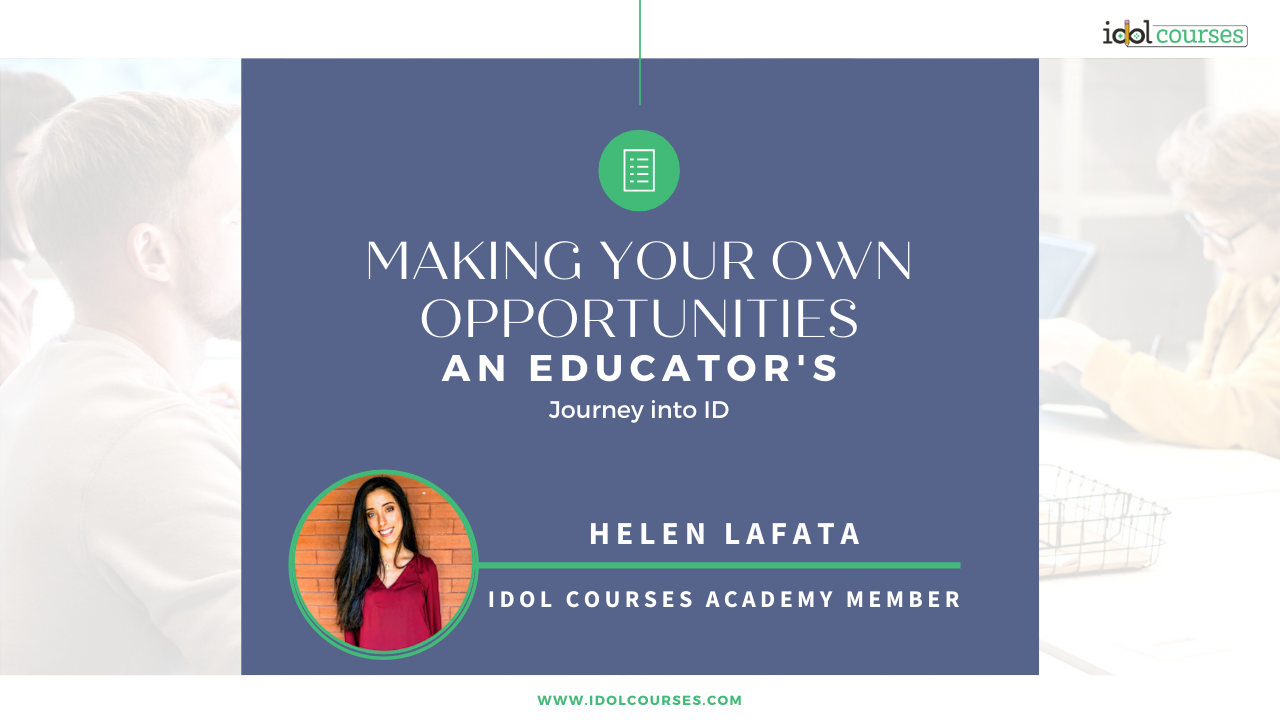Making Your Own ID Opportunities: An Educator's Journey Into ID
Oct 30, 2020

In an unfortunate era where Arts programs in schools are losing funding and shutting down rapidly, creating opportunities and advocating became my most valuable skill set as a public school teacher. One of the best pieces of advice ever given to me as an Arts teacher was, “You have to create a program that is too visible and concrete for them to silently take away.” This meant creating community outreach and collaboration opportunities, showing off school pride, and presenting top-performing ensembles. As I made my transition into Instructional Design, I kept that tip and my grit for self-advocacy at the forefront of my game plan.
I knew shifting careers wouldn’t be easy, but I felt confident in my ability to successfully transfer my skill set and previous experience as an educator into that of an instructional designer. After all, a big portion of being an instructional designer is being an effective educator. I knew how to backwards design, create scaffolds, utilize a variety of teaching methods, identify objectives, collect data, reflect and reiterate. The IDOL courses Academy helped me find the language to translate my pre-existing teaching skill set to that of an instructional designer. The biggest hurdle I knew I had to overcome was learning and utilizing new software and marketing myself as more than just a teacher.
Like most teachers out there making the transition into Instructional Design, I had the mentality of, “If I could just get my foot in the door, I know I would do great!”. But that mentality was always shaken by job posts with daunting qualification requirement lists that always began with “Required 2+ years experience”, facing me with the dreaded Permission Paradox which states, “You can’t get the job without the experience, but you can’t get the experience without the job.”. I began to feel frustrated with my portfolio assets as they felt incomplete, lacking the depth and applicable context and training applications that one would develop for a real-life client. It was at this point I knew I needed to create my own opportunities and become my own advocate. I needed to find an internship or volunteer my services to a company who would allow me to build out assets and gain real-life field experience.
When COVID-19 hit, I found I had more time to invest in my freelancing business, which is language translation. I secured contracted work translating training materials and curriculum for a non-profit organization. After translating my first few units, I realized this was the perfect opportunity for me to create learning assets for my portfolio, and gain some experience in the field of instructional design. I reached out to my supervisor and confidently offered my services. She responded with friendly enthusiasm and assured me she would look into it further. So I waited, I checked back in, I waited some more and so the cycle continued. Finally, I decided that I needed to take action. I created a sample learning module and a variety of assessments based off of the materials within a unit I was translating. I created a storyboard, described my design process through a well documented case study and presented my learning module and scheduled a meeting with the CEO of the company.
Leading up to the meeting, I knew I had to clearly define why the company needed to transition their training materials into a digital format, how it would benefit the company and why I was the right person for the job. I created an asynchronous learning module that allowed the learner to navigate information at their own pace, check their understanding through formative assessments and engage in interactive learning. The CEO loved it. The CEO now had a tangible asset that allowed her to see what the future of professional development and educational scaffolds could look like. More importantly, she saw my determination, my experience as an educator, my work-ethic, and my ability to create opportunities.
My biggest piece of advice for those of you out there struggling to find the right opportunity is to create your own opportunity. Build something that prospective employers can’t ignore. Take initiative and show them why they should hire you. By taking developing and pitching a design to a prospective employer you are not only showcasing your ability to create opportunities and advocate for yourself, but your ability to create opportunity and advocate for your new company.
Written by: Helen Lafata
Helen Lafata is an instructional designer and training manager in Denver, Colorado. She enjoys the creative outlet that her profession as an ID allows her to exercise everyday!
Stay connected with news and updates!
Join our mailing list to receive the latest news and updates from our team.
Don't worry, your information will not be shared.
We hate SPAM. We will never sell your information, for any reason.



